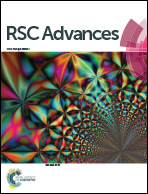A highly selective multi-responsive fluorescence sensor for Zn2+ based on a diarylethene with a 4,6-dimethylpyrimidine unit†
Abstract
A novel turn-on mode fluorescent diarylethene containing a 4,6-dimethylpyrimidine unit was developed to fluorescently sense Zn2+. Its multiple-responsive properties induced by Zn2+/EDTA and ultraviolet/visible light have been systematically studied. The fluorescence sensor could efficiently detect Zn2+ with a 10 times enhancement of emission intensity and fluorescence color change (dark-green). In addition, the sensor showed clear discrimination from Cd2+. The limit of detection of the sensor was measured to be 8.48 × 10−8 mol L−1 for Zn2+. Finally, a molecular logic circuit was fabricated with the emission at 528 nm as the output signal and light and chemical stimuli as input signals.



 Please wait while we load your content...
Please wait while we load your content...